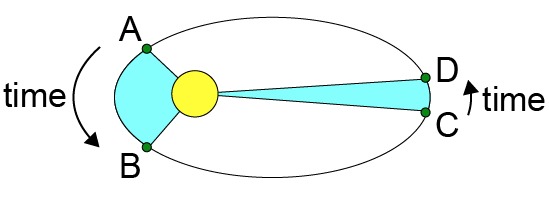How does the Earth orbit the Sun?
How does the Earth orbit the Sun?
The Earth does not orbit the Sun on a completely circular path. In the early 17th century, Johannes Kepler discovered that the planets of our solar system orbit the Sun on elliptical paths. Of the planets in our solar system, only the orbit of Venus is close to a true circle.

All the planets orbit the Sun in the same direction, counterclockwise from the North Pole of the Sun. The orbit of a planet around the Sun determines the length of the planet's year. The shortest year in our solar system, 88 days, is on Mercury, whereas the longest year, about 248 years, is found on the dwarf planet Pluto. A year on Earth lasts for exactly 365.26 days.
Did you know that the Earth does not always orbit the Sun at the same speed? When the Earth moves from point A to point B, it takes the same amount of time as moving between points C to point D. The area of points A and B and the area formed by the Sun, on the other hand, is equal to the area of the area formed by the Sun and points C and D. Since the distance from point A to point B is much longer than the distance from point C to point D, the Earth must travel much faster near the Sun. This can be explained by the gravitational force that influences our planet. When the Earth is close to the Sun, the Sun attracts it more strongly. In order for the Earth to still stay in its orbit and not change its direction toward the Sun, it must therefore travel faster.
The same law is followed by the comets that arrive at our solar system from its outermost edges. The Moon also orbits the Earth in a similar way.